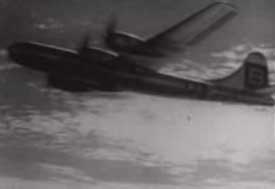 Joe Bonica ran a "movie of the month" subscription film studio in the 1940s selling 8 & 16 mm films for the home projection market. They were mostly only about three minutes each.
Joe Bonica ran a "movie of the month" subscription film studio in the 1940s selling 8 & 16 mm films for the home projection market. They were mostly only about three minutes each.
A great many of his films were of beach babes & semi-nudes for the adult market, but others were authentic newsreels. The one-reel film titled Atom Bomb consists of three individually made short-shorts. These are:
Atom Bomb (1946), Survival Town Atom Test (1955), & Operation "Teapot" Atom Test (1955). The "Teapot" footage is from Pathe News, the original Warner Pathe film exceeding twenty minutes as News Magazine of the Screen: Atomic Energy (1955).
The first & oldest short-short Atom Bomb documents the atom bomb testing at Bikini Atoll, an ironic subject for a company that made films about girls in bikinis.
It's not an honest piece of newsreel footage as we don't see the Bikini islanders forcibly removed (to this day they dream of returning to their native islands, but radiation levels are still not safe).
It's a gung-ho America has big bombs film. But in retrospect it's more horrific than it intended to be, as we see navy men on a ship's deck "protecting" themselves from the flash & radiation by sitting down & covering their eyes with their arms. Others are shown wearing sun-goggles as their only protection.
The government rather than Bonica was the actual producer of this footage, & the point was propagandistic. It set out to show both how fanastically destructive the bomb was, & secondarily how harmless it would be to people close enough to be irradiated.
What a propaganda outlook can't say is that the guys we see irradiated in this film became known as the "fodder unit," & though there was plenty of advance notice on how dangerous exposure would be, they were intentionally used as lab rats. The fact that many of these young men soon died from radiation exposure, & survivors had serious health issues the rest of their shortened lives, is even today rarely mentioned.
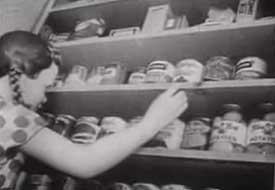 The seriously misnomered Survival Town Atom Test is about the U.S. Atomic Energy Commission's Test Site in Mercury, Nevada.
The seriously misnomered Survival Town Atom Test is about the U.S. Atomic Energy Commission's Test Site in Mercury, Nevada.
It shows the construction of buildings made of various materials which were inside the nuclear test perameter, to test the degree of damage. Lifelike manikens represented the lives who'd be inside the parameter, & shelves & shelves of food to see how it was effected.
Though only lifesized dolls were officially being tested, in reality a great many soldiers were stationed within a mile of the explosion to see how the radiation effected them. These soldiers did not know they were guinea pigs & their sorry-ass fates are not part of this propoganda film.
Six thousand spectators showed up with no protection beyond sun goggles, many bringing their cameras, many ducking into trenches that would be completely dusted with radiactive debris.
"Survival Town" should've been called "Doom Town" since it was completely destroyed, with only a concrete bunker's concrete left standing a mile away. The propogandistic narration, however, concludes that this proved it was possible to survive all out nuclear war.
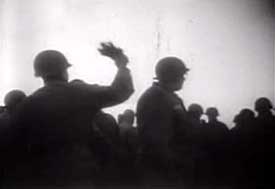 Operation "Teapot" Atom Test (1955) furthers the "research" of radiation effect on humans. Nine thousand servicemen were positioned so as to be irradiated, though never informed of the danger.
Operation "Teapot" Atom Test (1955) furthers the "research" of radiation effect on humans. Nine thousand servicemen were positioned so as to be irradiated, though never informed of the danger.
This gung-ho propoganda film just shows some basic facts as though it were no big deal to experiment on soldiers & aims to reassure the public that it really is safe to be near atomic blasts.
When the bomb goes off the narrator boasts of the men huddled where radioactive dust will fall all over them. "Never before have men had such a close-up view!" Well yippy.
Curiously the narration is quite clear as to how dangerous the dust is, but dissmissively speaks of "the vitally important precaution of dusting each other off," as we watch one soldier use his gloves to scatter dust off the shoulder of a fellow soldier.
Not all clear from this three-minute film is that Operation Teapot was actually a series of tests with fourteen bombs detonated in the Nevada desert beginning spring of 1955, just one in a series of Operations with multiples of bombs.
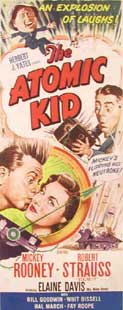 Shouldn't analyze The Atomic Kid (1954) too closely, as politically there wouldn't be much to approve of, in a film that sets out to show how much lighthearted fun can be gotten out of the Atomic bomb & radiation. It's a funny-ha-ha tale about the same event shown in Survival Town Atom Test. Shouldn't analyze The Atomic Kid (1954) too closely, as politically there wouldn't be much to approve of, in a film that sets out to show how much lighthearted fun can be gotten out of the Atomic bomb & radiation. It's a funny-ha-ha tale about the same event shown in Survival Town Atom Test.
The majority will not find it such a "har har" because instead of losing his teeth, hair, skin, & life, our hero merely glows in the dark. The nearby military servicemen watch the
test explosion from the alleged safety of a trench, whereas the real life
tests with personnel nearby resulted in illnesses & death.
Those of us of the "boomer" generation would've already learned from the movies that radiation causes giant ants & human superpowers, & in case of nuclear holocaust, we kids would be safe at school just so long as we hid under our desks. So it's not that hard to accept this film as one more rather propogandistic product of its era, accepting it as a surprisingly entertaining romantic comedy.
Mickey Rooney is Barnaby "Blix" Waterberry, a uranium prospector who follows his geiger counter to a test-house in the desert where a family of mannikins are nicely arrayed at the dinner table. He rummages through the sundries, & has a peanut butter & horseradish sandwich. He is quite slow to realize he's standing inside an atom bomb target. Oh ain't that one funny, the gaffer's gonna be vaporized, hee hee.
But the military soon discovers a living man at the bomb site who actually survived an atomic bomb at close quarters. Glow-in-the-dark Blix is a speeded up mouse-voiced frightened weirdo zipping about crazily. More har har funny, especially if you're eight years old, as I was the first time I saw The Atomic Kid as a television matinee, & decided it was my favorite movie for a while, watching it several times over the next few years since it was in one of the local station's film collections.
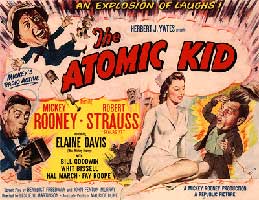 On adult reflection, obviously, it's not that good a movie, but even so an interesting relic of the early Atomic Age, & not the worst Mickey Rooney comedy ever. On adult reflection, obviously, it's not that good a movie, but even so an interesting relic of the early Atomic Age, & not the worst Mickey Rooney comedy ever.
Ten years earlier Mickey had been a top box office draw, but by the fifties his star had dwindled. Still, I like some of the ridiculous bits in this little film.
Blix's "winning" journey to Vegas can still win a smile. The attempt of advertisers to get him to say it was their brand of peanut butter he ate at Ground Zero is pretty real & pretty funny. As slapstick goes, a guy who causes explosions when he sneezes is fairly original schtick.
Co-star Robert Strauss is in some ways the more interesting comic. He was a great character actor who you'll instantly recognize as from "something" you've seen before -- think Stalag 17 (1953). But this weak comedy may be his only full-blown co-starring role. Strauss & Rooney come off a bit like Laurel & Hardy, or Abbott & Costello, & had they gone on to do half a dozen films together they'd likely be remembered as a good comedy team.
Though it's hard to believe now, in his day Mickey was regarded quite the ladies' man, both on & off the screen, & so there's a love story wound through this comedy, Audrey being played by Elaine Devry, Mickey's fourth of many wives.
There's also some poking fun at "cold war paranoia" winding through the tale, in the subplot of spies trying to capture the Atomic kid.
Unfortunately for Mickey, even in the most romanticized moments of the "glorious" Atomic Age, cold war paranoia was all too real. People weren't eager to laugh at how funny Soviet spying might be, & the stock footage of the test-house's actual eradication by a nuclear explosion didn't strike film-goers as the funniest thing they might pay to see, in a film with no honest awareness of its subject, no satiric bite or honesty about it.
Thus the film was a bomb, so to speak, for its initial box office, & was for decades a rather hard film to get to see unless your local tv station had their own copy to show periodically. The vhs/dvd era was not hasty to make it available, either, though it's now out there for the five or six remaining fans of Mickey Rooney to purchase, & many more to rent or borrow. And I wouldn't say skip it.
copyright © by Paghat the Ratgirl
|
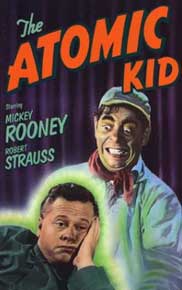




 On adult reflection, obviously, it's not that good a movie, but even so an interesting relic of the early Atomic Age, & not the worst Mickey Rooney comedy ever.
On adult reflection, obviously, it's not that good a movie, but even so an interesting relic of the early Atomic Age, & not the worst Mickey Rooney comedy ever.